Este post também está disponível em:
Português
English
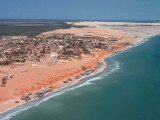
The east coast of Ceará that extends between Aquiraz and the border with Rio Grande do Norte is known by the name of Costa do Sol Nascente.
The east coast of Ceará comprises the municipalities of Pindoretama, Cascavel, Beberibe, Fortim, Aracati, Icapuí and Itaiçaba.
All along the east coast of Ceará you can see white sails that gain the sea even before sunrise, in a movement that is repeated every morning when fishermen push their rafts towards the ocean.
Visiting the east coast of Ceará, in addition to the sun and the dunes that make up beautiful landscapes, is to be in the midst of a culture that maintains its authenticity even on the busiest beaches.
The short distances between the various beaches of the east coast of Ceará of this stretch of coastline traveled by the CE-040 highway allow pleasant day trips.
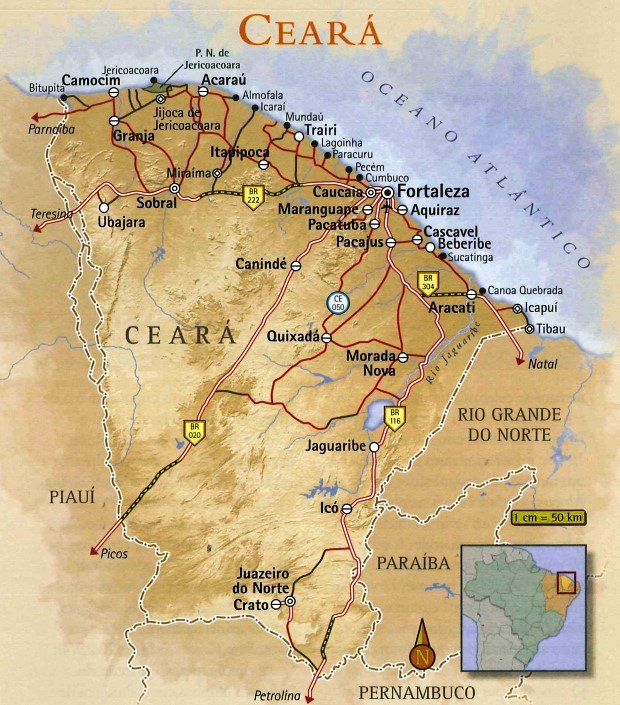
MAIN BEACHES OF THE EAST COAST OF CEARÁ
View the map of the east coast of Ceará


Jericoacoara no Ceará
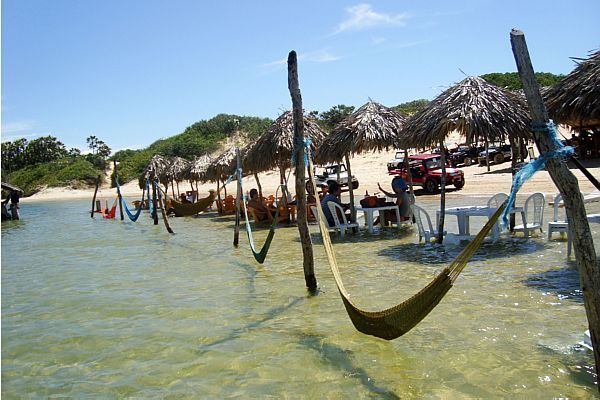
Lagoa da Tatajuba no Ceará

Canoa Quebrada de cima

Litoral Leste do Ceará
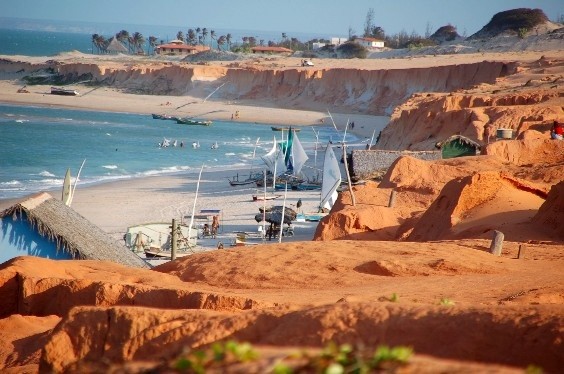
Canoa Quebrada no Ceará
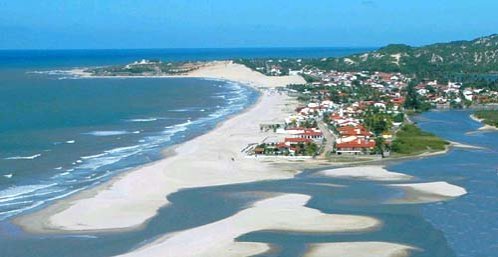
Aquiraz noCeará

Praias de Beberibe no Ceará

Praia das Fontes em Beberibe

Praia do Morro Branco em Beberibe

Praia do Canto Verde em Beberibe

Cascavel no Ceará

Icapuí no Ceará
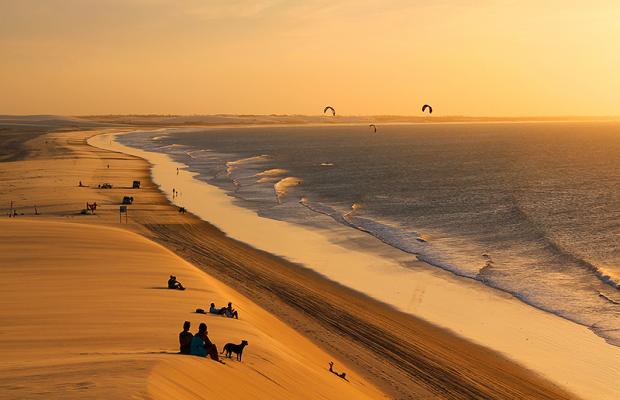
Top 5 Praias do Litoral Leste do CEARÁ
1. CITY OF AQUIRAZ
Aquiraz on the east coast of Ceará has besides its historical-architectural value, Aquiraz has as main natural attractions 36km of beautiful beaches.
The main beaches are:
- Porto das Dunas (where Beach Park is located)
- Praínha
- Praia do Iguape
- Presídio
- Barro Preto
- Batoque
All the beaches of Aquiraz have similar characteristics, such as tropical climate and constant breeze, development in the tourist sector of high standard, maintain the fauna and flora of the places and offer tourists services with quality in restaurants, inns and in the tents.
There are several options for tours in Aquiraz.
In the Historical and Cultural Center you can visit the Igreja da Matriz, the Ruinas dos Jesuítas, the Sacred Museum, Praça da Matriz, the Mercado Velho, the Vila do Capitão Mor, the Centro das Rendeiras, the Porto das Jangadas and the Centro de Artesanato, where you can find bobbin lace, labyrinth and embroidery pieces, as well as perfect replicas of rafts, in miniatures ranging from 30 centimeters to almost two meters.
There are also other good leisure options, such as raft trips along the rivers of Iguape and Manguezais, or in the lagoons, as well as longer trips, in neighboring Beberibe, to see the cliffs of Praia do Morro Branco and the dunes of Praia das Fontes.
In 1713, the small village of Aquiraz, the scene of violent clashes between Europeans and Indians, was elevated to the status of a town and played the role of seat of the captaincy of Siará until 1726.
The city, 32 kilometers from Fortaleza, preserves buildings from colonial times and the interior climate – although today it is intensely sought after due to Beach Park, a large enterprise that attracts tourists from all over the country.
1.1 MATRIX CHURCH AND SACRED MUSEUM OF SÃO JOSÉ DE RIBAMAR
Built in the mid-18th century, the Mother Church of São José de Ribamar has undergone several changes over time, which resulted in the mixture of neoclassical elements with the Baroque style.

The three large padded doors of the main entrance, the carved wooden pulpit and the painted panels on the ceiling of the chancel, with passages from the life of São José de Ribamar (Praҫa Conego Araripe, s/n, Centro) are original.
The São José de Ribamar Sacred Museum, with a collection of almost 500 pieces from the 17th, 18th and 19th centuries, is housed in a well-preserved townhouse that was once a town hall and jail and was built in 1877.
In the upper part, the ceiling reinforced with carnauba beams draws attention; the most important piece is a silver cross from the 18th century, brought to Aquiraz by Jesuit priests (Praҫa Conego Araripe, 22, Centro).
1.2. MINIATURE JUNGLES
Timbaúba, a wood native to the region, is transformed into small works of art in the hands of Seu Oliveira, a former fisherman from Prainha.
The craftsman, who learned the trade at the age of eight, spends much of the day on the porch of his house carving small rafts with the help of a sharp knife.
The perfection and richness of the details (sail, samburá, fishing line and other instruments used by fishermen) win the attention of tourists passing by the beach (Rua Damião Tavares, 349, Prainha).
The pieces can also be found at the Prainha Rendeiras Center.
1.3. BEACH PARK IN THE EAST LITTORAL OF CEARÁ
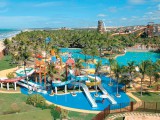
The Beach Park is located on the beachfront of Porto das Dunas on the east coast of Ceará, the park offers a wide range of leisure facilities for families, with seventeen water toys of all kinds – from the quietest, suitable for small children, to the most “radical”.
The complex includes snack bars, restaurants and stores.
There is no need to pay an entrance fee if the tourist is only going to enjoy the beach area and the bar and restaurant services. R. Porto das Dunas, 2734, Porto das Dunas.
1.4. KIOSKS
In the seven kiosks of the Centro de Rendeiras da Prainha, forty lace-makers take turns selling to tourists and making bobbin lace with thick or thin lines (more delicate and more laborious, which takes several days to complete).
Among the pieces are bedspreads and tablecloths (Rua Damião Tavares, s/n, Prainha).
At the Iguape Rendeiras Center, located near the dune and the fishermen’s shed, you can find labyrinth embroidery and bobbin lace. You can buy tablecloths, towels, bathing suits, tray cloths, clothes covers and even bags (Av. da Praia, s/n, Iguape).
1.5 MARKET OF ARTS
This 19th-century building, a former trading post and meat market, now houses a cultural center with art workshops, craft stores and a restaurant, as well as a public library.
The geometric harmony of the roof frame and the precise construction technique, supported by the use of carnauba and adobe, are worth the visit (Rua Santos Dumont, s/n, Centro).
1.6. BEACHES IN AQUIRAZ
Aquiraz has not only the trendy and expensive Jericoacoara and Canoa Quebrada (at Aracati) lives the Ceará. Nearby Fortaleza is Aquiraz, just 27 km from the capital, on the east coast of Ceará.
1. Porto das Dunas

Porto das Dunas has white, soft sand and stretches conducive to surfing, it is the beach with the best infrastructure: it is fully occupied by hotel services, inns and condominiums.
2. Prainha
Always very crowded and sought after by excursions, it is dotted with tents. The harassment of guides offering tours and accommodation is intense.
3. Presidio
This resort is home to summer houses on a wide stretch of white sand, permeated by lagoons and bordered by the Salinas River. Famous for its street carnival on the sand.
4. Iguape
The most urbanized beach of Aquiraz, with white sands, calm sea and dotted with rafts, with a solitary dune. It has modest inns, as well as restaurants and stalls.
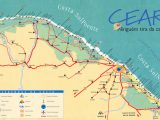
5. Barro Preto
Straight, with dark sands, coconut trees, some summer houses, small hotels and tents. The buggies stop at the picturesque tent of Giovane Cavalcante, decorated with scrap metal.
6. Batoque Beach
Isolated, with few tents, dunes, cliffs and nearby lagoons, as well as clear sand and calm sea. Access includes crossing over a stretch of the Barro Preto River.
2. CITY OF ARACATI
Aracati on the east coast of Ceará is well known for its natural beauty, has the Canoa Quebrada Beach as its postcard. It is one of the most frequented beaches in the state, receiving many tourists during the summer. Its beautiful landscape and infrastructure are ideal to enjoy a great day at the beach.
The nightlife is also hectic, pleasing those who like fun, being able to stop at a bar or restaurant.
The city of Aracati has good infrastructure, with hotels, inns and restaurants, which serve typical dishes of the local cuisine.
The practice of sports is favored, and for those who like adventure, hiking the cliffs in Canoa Quebrada is a good option.
It is an ideal place to relax, replenish your energy and enjoy a beautiful weekend.
2.1. BEACHES IN ARACATI
Porto Canoa can be reached on foot from the neighboring Canoa Quebrada.
The landscape with reddish cliffs contrasts with the white sails of the rafts that rest on the sand. Good for bathing, Majorlândia concentrates the colorful cliffs from which the sands were taken to decorate the famous gar rafinhas sold throughout the state of Ceará.
It has an infrastructure of bars, restaurants and inns, in a beach region framed by coconut trees and white and red cliffs. In October, the beach is the starting point for the Majorlândia Raft Regatta.
Between white cliffs, Quixaba beach is recommended for those seeking tranquillity, as is the semi-deserted Lagoa do Mato, reached on foot or by buggy. To reach the small lagoon that gives the beach its name, you have to climb the dunes.
At Fontainha, where the sea is not suitable for bathing, the colorful dunes reappear. Retirinho is a small stretch of coastline demarcated by a reef; in Retiro Grande, next, as well as in cozy Ponta Grossa and small Redondas, there are sargasso and a small fishing village perched on the cliffs.
1. Majorlândia
It is located 12 km from the seat of the municipality of Aracati and 170 km from Fortaleza and 6 km from Canoa Quebrada, a neighboring beach.

Majorlândia is a fishermen’s village and was founded in 1937 by Major Bruno da Silva Figueiredo (Majorlândia = ‘Major’s Land’).
Dense coconut groves and reddish white cliffs dominate the beach of Majorlândia.
Dense coconut groves and white and reddish cliffs dominate the beach of Majorlândia. The fishermen’s rafts anchored along the beach harmonize with the beauty of the place.
Majorlândia beach is a great place to visit.
Surfers take advantage of the strong and constant waves.
Majorland has been credited with the origin of the famous colored sand bottles created by local artisans.
Another attraction of Majorlândia beach are the giant sculptures carved into the cliffs by local artist Toinho de Carneiro.
Majorlândia has infrastructure to welcome visitors: inns, bars and restaurants with an abundant supply of fresh fish and seafood.
With infrastructure of bars, restaurants and inns, it has landscape framed by white and red cliffs.
2. Quixaba Beach
It is located in the municipality of Aracati.
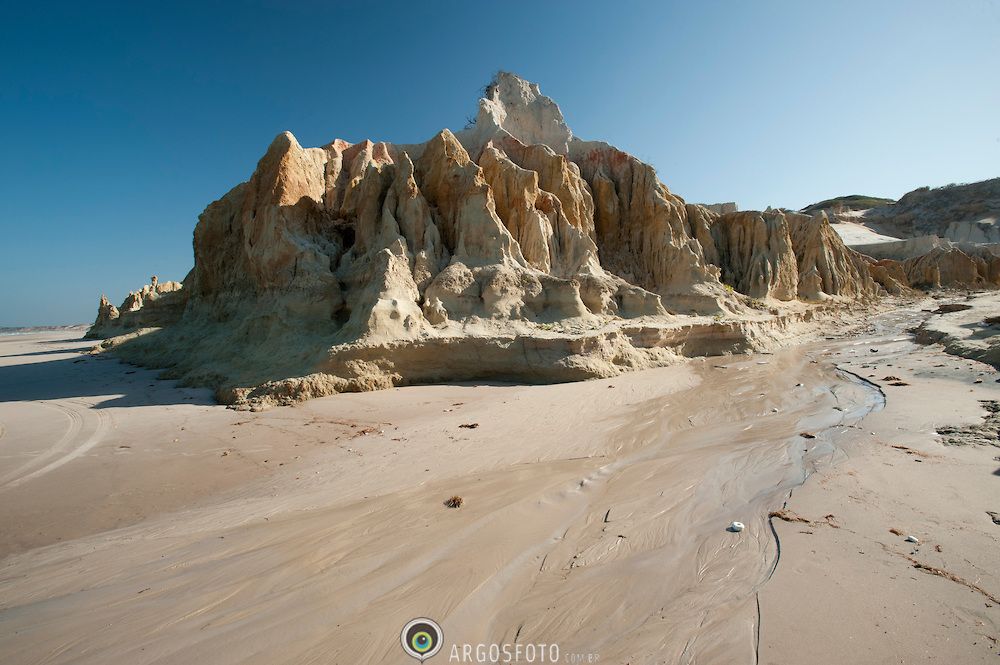
Beach in a fishing village, with few summer houses and guesthouses. It is surrounded by clear cliffs with some coconut trees spaced in the landscape.
4. Porto Canoa
Between reddish cliffs, beach where fishermen collect their boats to rest at dusk – hence its name.
5. Lagoa do Mato
Deserted and preserved beach, with rare buildings, is crossed by buggies during the tours.
6. Fontainha
Short stretch of clear sand, surrounded by colorful dunes. The sea, with strong waves, is only explored by fishermen.
7. Retirinho
A stretch of reef rises between the sea and the beach; in the bay, during high tide, the sea reaches the reddish cliff.
8. Retiro Grande
Sargasso sea and dark sand in a small fishing village, with a few houses perched on the cliffs.
9. BROKEN Canoe
The beach of Canoa Quebrada on the east coast of Ceará is the most famous of the east coast of Ceará is located in the municipality of Aracati, 161 kilometers from Fortaleza.
The town, which grew rich in the 18th century thanks to the jerky trade, is now known for its lively street carnival, although accommodation options are quite limited.
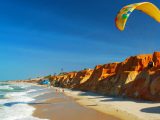
In Aracati, the conservation of the houses remaining from the colonial period, sometimes covered with Portuguese tiles, leaves something to be desired, but the buildings still attract the attention of those who cross the city towards BR-304, the main access to Canoa Quebrada – by far the great local attraction, with good tourist structure, as well as bars and restaurants.
Canoa Quebrada is a place of magic that surprises everyone with so much animation and paradisiacal beauty! The dunes, cliffs, sea and bright sun are inexhaustible sources of energy and inspiration, making it a paradise for those who want to let themselves be conquered by this seduction.
From Aracati you can also reach the highway CE-261, which leads the visitor along the beaches of the Ceará coast to the border with the state of Rio Grande do Norte.
In the 1970s, Canoa was discovered by hippies who were enchanted by its landscape of calm waters and dunes.
The transformation that has taken place in the town in recent decades is symbolized by the change of name of its main street: the old Dragão do Mar street – nickname of the jangadeiro who was notable for his militancy against slavery – is now called, melancholically, Broadway, because of the bars and pubs where the evenings extend until dawn.
2.2. FROM BUGGY BY THE LITTORAL
From Canoa Quebrada there are two options for buggy rides. One of them goes through the beaches of Porto Canoa, Majorlândia, Quixaba, Lagoa do Mato, Fontainha, Retirinho and Retiro Grande, ending in Ponta Grossa, where you can see the most beautiful sunset in the region from the top of a large dune – the ideal is to do the program in the afternoon, to enjoy the landscape and escape the strong sun, since the tour lasts no less than three hours.
Another alternative is a shorter tour, of only one hour, on a route that goes from Porto Canoa to Quixaba.
The buggies can be hired in the inns and hotels of Canoa Quebrada or the neighboring localities, or even in the center of the village. Do not forget to check the driver’s registration with the Ceará Tourism Secretariat.
3. CITIES OF CASCAVEL AND BEBERIBE
Cascavel, 64 kilometers from Fortaleza by CE-040, stands out for its beautiful beaches and rich handicrafts.
Beberibe, in turn, is a small town, without urban attractions, 83 kilometers from the capital and 20 from Cascavel. In this region, however, are two of the most famous beaches of the east coast: Morro Branco and Praia das Fontes.
3.1 BEACHES IN BEBERIBE
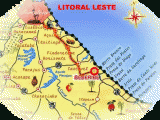
The postcard is Morro Branco on the east coast of Ceará, the busiest beach, four kilometers from the center and also surrounded by dunes and reefs.
Of the beaches of Beberibe, the ones that stand out the most are Praia das Fontes and Praia de Morro Branco, surrounded by the Falésias Natural Monument.
Morro Branco is also one of the most popular scenarios for buggy rides. The tour includes stops near the cracks of the Labyrinth of Cliffs, formed by erosion and sands of various shades.
It is also on the beach – especially in the village square – that visitors find the traditional bottles decorated with grains of colored sand.
By buggy you can reach the beautiful Fontes beach, with freshwater spouts, caves, dunes, cliffs and calm waters that attract families. For those with little ones, it is worth including in the itinerary the Lagoa do Uruaú, surrounded by tents with tables almost in the water and boat, jet ski and kayak rides.
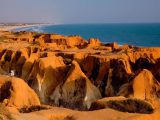
Further away are the beaches of Diogo, not very busy and accompanied by dunes and freshwater spouts; Barra do Sacutinga, with a fishing village, cliffs and kiosks; Ariós, accessible by buggy; Prainha do Canto Verde, quite quiet; Paraíso, deserted and dotted with lagoons; and Parajuru, with tents and temporary streams.
1. Morro Branco
With infrastructure of bars and restaurants, it is the most sought after beach by tourists.
2. Fontes and Diogo Beach
Reddish cliffs dominate the landscape from the beach of Fontes, with calm sea and edge occupied by summer houses. On Diogo beach, the houses are located on the cliffs.
3. Uruaú beach and lagoon
Also known as Marambaia beach, it has a continuous stretch of white sand. Although it is an Environmental Protection Area, the lagoon is used for water sports.
Barra de Sucatinga: surrounded by reddish sand formations. On the beach you can see rustic tents and sea sparsely punctuated with rafts.
3.2 BEACHES IN CASCAVEL
Cascavel with fewer beaches on the east coast of Ceará, is known for its tranquility and warmth. It has beautiful landscapes, such as the beaches of Águas Belas and Caponga, postcards of the city.
It is a good travel option to spend a few days of vacation, where you can relax and take a refreshing swim in the sea. Both beaches have good infrastructure, with kiosks serving fresh fish snacks.
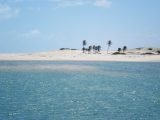
The city has hotels and inns, as well as bars and restaurants.
The tourist can choose between resting on one of the beaches, taking a walk around the city, knowing some historical points or enjoying a snack by the sea. Playing sports is also a good option, whether surfing or soccer. It is a good place to enjoy a family vacation.
1. Capanga
Urbanized, it is in a cove where summer houses of Fortaleza are concentrated. It has white sand and calm sea, with reefs, and is home to one of the largest raft ports on the Ceará coast.
2. Águas Belas
Quiet, with a fishing colony, it begins at the end of the cove of Caponga. Its landscape is marked by dunes and coconut palms, and the Malcozinhado River, with mangroves.
3. Barra Nova
Small deserted beach, with mobile dunes and coconut palms, and with a strip of reefs in the sea. Accessible only by vehicle with traction or by walking along Águas Belas beach.
3.3 Handicraft center in cascavel
The handicraft center of Cascavel on the east coast of Ceará is located right at the entrance to the city. Among the pieces exhibited there are ceramic works of indigenous and Portuguese influence from the neighboring community of Moita Redonda and furniture and objects made of cipó-de-fogo, typical vegetation of the forests seen in its surroundings. CE-040, km 56, entrance to Cascavel.
3.4. STREET ENGINEERING
The CE-040, between the cities of Aquiraz and Cascavel, is punctuated by several sugar cane mills where you can follow the preparation of rapadura, alfenins, mill honey, cane brandy and mascava sugar.
All these products derived from sugar cane can be tasted during the visits.
Among the mills, Casa Grande stands out, where the largest rapadura in the world is on display. You can also see the old ox-drawn mill and the current production mill (CE-040, km 37).
4. BEACHES IN ICAPUÍ
Beaches surrounded by coconut groves and cliffs attract tourists to Icapuí.
On the border of the east coast of Ceará with Rio Grande do Norte are beaches surrounded by coconut trees and cliffs built thousands of years ago. The landscape reveals dunes, cliff walls and the coming and going of fishing rafts.
In Icapuí on the east coast of Ceará, 200 kilometers from Fortaleza, is the Ponta Grossa Beach. The visitor can understand how the cliffs are formed over thousands of years by the action of sea water and, in addition, the tourist can invent his own trails by natural sculptures during the walk along the beach.
Caves, colored rocks and curious formations accompany the path along the almost always deserted beach.
In Icapuí, Praia da Redonda is the one with the most structure of inns and restaurants. The sea is always calm and the landscape mixes dunes and cliffs. Most inns are strategically located to offer the scenery as the main attraction.
The city of Icapuí is known for its abundance of lobster. Those who visit the municipality cannot miss eating the delicacy in mango sauce.
At the other end of the coast of Icapuí, the cliffs give way to the mangroves that surround the Requenguela Beach. An environmental station offers free fun and ecology lessons. All on a 240-meter suspended trail that crosses the mangroves.
At the end of the walkway tourists come across the so-called Barra Grande, with a unique feature: at low tide the sea retreats up to three kilometers providing the incredible look of the beach. Cliffs on one side, mangroves on the other and even the beach that changes with the tides.
Icapuí presents itself in a different way at every corner, on every walk.
The coastline of Icapuí has fifteen beaches. Ponta Grossa was considered the cleanest in Ceará in an assessment made by the state’s Environment Secretariat and Ibama.
1. Ponta Grossa
From the top of its cliffs, you have a beautiful view of the sunset. With weak waves, this small beach invites you for a swim.
2. Redondas
Beach with strong waves and surrounded by reddish cliffs, you can reach it on foot, at low tide, from Ponta Grossa.
Tourism and Travel Guide of the East Coast of Ceará



















